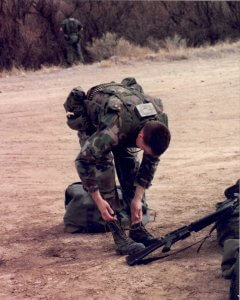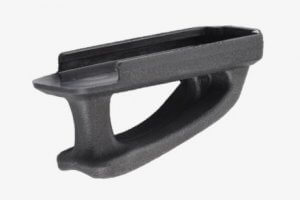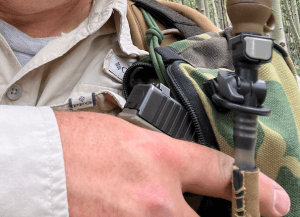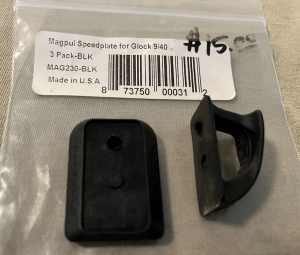Magpul Speed Plates for Glock

. . . and Other Magazine Pullers
As the name implies, Magpul got their start by making magazine pullers, aftermarket accessories for GI M16 magazines that you could grab to help you pull the magazine out of its pouch.
The standard ALICE mag pouches held three M16 magazines. Each had a pair of nylon straps inside that was supposed to go between the magazines and keep them aligned with the bullets facing away from the soldier (it was more comfortable to have the curved spine of the magazine against your hip than the pointy corners of the fronts of the mags against you).

Most of us moved the pouches, which were supposed to go more or less at about 10 and 2 o’clock in front of you, around to 3 and 9 on the sides of our hips (to make it easier to low crawl). We cut the nylon straps out so we could put the mags in sideways, with the bullets facing backwards. That enabled us to grab the outermost mag from the side in what I later called a gorilla, or c-clamp, type grip.
Since there was only about an inch or two of the mags sticking out when your pulled open the top cover of the pouch, you didn’t have much purchase to grab the bottom of the magazine. It wound up being a two-step process:
- Pull the mag partway out
- Get a better grip on it and pull it the rest of the way.
We were issued live ammo every day. Most of the folks I worked with only pulled their mags from their pouches the end of their shift. A few of us, myself included, represented our base in combat competitions, so I pulled my mags quite frequently throughout the day, on the rifle range in the morning and during tactical exercises (with MILES, like laser tag) all afternoon, every afternoon.

Some folks duct taped 550 (parachute) cord loops to the bottoms of their magazines to make them easier to get started out of the pouch. The more ambitious pulled the cores from the outer sheath of the 550 cord, tied it in a loop, took off the base plate of the magazine, looped the 550 cord sheath around it, and then reinstalled the base plate of the magazine with the knot inside. That was more robust and less prone to failure than the duct tape solution. I tinkered with this too, but never struggled getting my mags out of my pouches enough to feel it was worth it.
For one thing, removing the base plates of standard metal GI M16 / M4 magazines, like removing the base plates of OEM Glock magazines, can be quasi-destructive. You can get away with it, but it wears on the parts. With metal GI magazines, you ran the risk of bending the base plate (which could be bent back straight easily enough) or worse yet, breaking off one or more of the tiny flanges (bent tabs) at the bottom of the mag body that held the base plate in place.
Removing the base plates of Glock magazines wears down the nubs on the sides that keep the base plate from popping off accidentally (see Catastrophic Failure of an OEM Glock Mag for an unusual example of a base plate coming undone).
Richard Fitzpatrick, who later founded MagPul, was a Recon Marine when Macho and I were in the Security Police. He felt there must be a better way, and he created it: rubber sleeves that wrapped around the bottom of the magazine, with had a lateral rubber loop you could pull on.

I admired the idea when I first saw them. They had the additional benefit of cushioning the impact when the mag dropped on its bottom, although dropping on the opposite end and bending the metal feed lips was far more of a problem. That was before the market got flooded with plastic mags for ARs.
Clearly thousands of other GIs liked them, because Magpul became an economic powerhouse in the defense industry. But again, I never really struggled getting my mags out. Such accessories were a nice to have, not a need to have, for me.
I got off active duty in the early 1990s. In the second half of the 1990s, when Magpul was starting to take off, I carried an M16A1 (and then an M4A1) as I patrolled the Rio Grande in a different uniform, that of a BP agent. In the Patrol, instead of military ALICE gear, I carried my (single) spare M16 magazine in an open topped leather pouch at about 8 o’clock on my River belt. That pouch bared the bottom third of the magazine (which was, of course, upside down) for me to grab should I need it. Some of my fellow patrulleros and patrulleras had those rubber Magpul magazine pullers on their mags, but again, I never felt the need. They would’ve been that much more hanging off of me to get hung up on the brush as I chased coyotes.
Now Magpul markets a Ranger Plate for M16 / M4 and AK magazines which replaces the entire base plate and has a fore-aft Santoprene rubber loop built into it. It’s more streamlined than their original lateral rubber loops.

Far a while, MagPul made something similar for Glock magazines, called a Speed Plate.
As far as I can tell, Speed Plates wouldn’t serve much purpose on Glock 19 and 17 magazines. Enough of those longer magazines sticks out of most pouches to get a good “finger along the front” grip in the pouch. But 10 round Glock 26 magazines aren’t very long; not much of them sticks out of a standard sized pistol magazine pouch. The Speed Plate does give some purchase to pull a 26 mag out, as well as providing a pinkie rest for the bottom finger hanging below the frame of the gun. Glock 26s (and 27s) don’t have enough grip for more than the middle and ring fingers of people with normal to large sized hands. Somebody with really skinny fingers might be able to get half a pinkie on there.
Which is why Glock (and Magpul) make “+2” extensions for the Glock 26 mags. They give you a place to rest your pinkie, if concealment in a small space (such as a pocket) is not a major issue. They also grant a little more capacity. Again, see Catastrophic Failure of an OEM Glock Mag for more information about Glock baseplate and “+2” extension options.
Being able to pull the a spare magazine out of the pouch is not a problem in free states, where one can carry standard sized magazines from larger Glock models as spares. But if one is visiting, say, the PDRK (People’s Demokratzik Republik of Kalifornia), where there are asinine round limits on (only) the law abiding, one must carry 10 round magazines. I have to carry 4 to take the place of the 2 Glock 17 spares I normally carry. Fortunately, I’ve eaten a lot of doughnuts, so I have some room on my belt. Not sure what skinny people do.
Either way, it helps when I do to have a handle, like the Magpul Speed Plate, to pull those short Glock 26 magazines out of their pouches.
Assistance with the Draw from Non-standard Holsters
I have a few of my Glock 26 mags set up with Magpul Speed Plates, and not so much as spare mags (I avoid the PDRK when I can).
When I drive cross-country, I keep a day pack in the car, for hikes along the way. I like to hike in general, but when I’m driving long distances, hiking also helps to stretch my legs and reduce the likelihood of deep-vein thrombosis (even though I’m more likely to get that from binge-watching TV on my couch than I am from occasional cross-country drives).
My day pack has a pouch for a small pistol. It fits, for example, a J-frame smith, or a Glock 26.

Carrying my roscoe on a shoulder strap, instead of on my hip, helps in two ways.
- It’s less weight on my hips to pull my pants down as I hike (which can happen because I’m egg-shaped).
- The shoulder straps would also make my pistol “print”–it would be readily apparent that I’m packing heat under my shirt–if I left the pistol in its hip holster.
There are two potential problems with that soft-sided pouch. One is that it is soft-sided, which is not a problem with a double action, J-frame Smith, but can be an issue with Glocks, which have lighter, shorter trigger pulls. It wouldn’t do to have the trigger manipulated through the cloth. I solve this problem with a Kydex trigger cover, affixed to the day pack with some parachute cord.
The second problem is that the “angle of the dangle” makes the pistol difficult to get started out of the pouch. The weight and position of the slide makes it want to stay in. That’s where a Speed Plate really helps.

When I unzip the pouch, just enough of the Speed Plate is accessible for me to pull it out a bit. That enables me to get a full grip on the pistol to complete the draw.

Although carrying on my shoulder strap violates Bianchi’s Law–that you should carry your pistol in the same place all the time, because you will reach for it there even if it is somewhere else–this arrangement works for me. It does require an additional step to separate the Glock from the Kydex trigger guard cover: I sweep my support side forearm against the 500 cord while pulling the pistol in the opposite direction. I’ve worked out a motion that’s fairly smooth and, importantly, keeps me from covering my forearm with the muzzle during the separation process.
Fortunately, most of the trails I choose are sufficiently less travelled that I can usually find an isolated spot pretty early on in the hike to get in some practice repetitions of that complicated draw, without alarming fellow hikers. It only takes a few reps to knock most of the rust off of the admittedly multi-step process. Then I feel I’m prepared, if 4- or 2-legged predators think I am (or another hiker is) on the menu.
Failure of a Speed Plate Under Normal Operating Conditions
Magpul products have a well-deserved reputation for being very robust.
However, I did have a Speed Plate come apart on me.
I was working with one, not long after I put a few on 10 round Glock 26 magazines for research & development. If you have time after you load or reload, it’s usually a good idea to give the base plate of the magazine a tug to ensure the mag is properly seated (locked into the magazine well). Normally I would do so by pulling on the sides of the base plate, but with the Speed Plate, I had a rubber handle to tug on.
I wasn’t pulling that hard, just enough to make sure the mag was locked in.
It was.
The front end of the rubber loop popped off of the base of the magazine.

I suppose I could glue it back on there, or send it back to Magpul, and they’d probably replace it. I say probably, because apparently, Magpul no longer makes them. You can still find Magpul Speed Plates for Glock Magazines at a variety of internet retailers, but I am unable to find them on the Magpul website.
I called Magpul in August of 2023. The rep I spoke with said that as far as he knew, Magpul had discontinued making the Speed Plates for Glocks about a year before. He told me they never did sell very well. Because Glock 19- and 17-sized magazines stick well out of most pouches, the Speed Plates were not very useful, despite my having found a particular niche for them on Glock 26 mags in my day pack pouch.
I suspect also that they simply weren’t as robust as other Magpul products, so the company decided to discontinue them rather than investing a lot into fixing the problem for a product that didn’t sell much anyway, rather than risking damage to their reputation for building solid equipment.
That two-piece speed plate was not unique. One of my others is coming loose as well.
The Magpul rep suggested several retailers who might be selling off existing stocks of the Magpul Speed Plates for Glocks. He warned me to be on the look out for knock-offs I might find on E-bay and other such sites. The Speed Plate I bought that came apart might be a knock off, although the packaging (and the Magpul emblems on the base plate) certainly appeared to be legit.
I keep it in my “Epic Fails” box, along with some other broken gun parts and accessories to show students that everything made by man, (including, Mas Ayoob points out, our parents’ children) can fail.

–George H, Heloderm’s chief product tester and food taster
